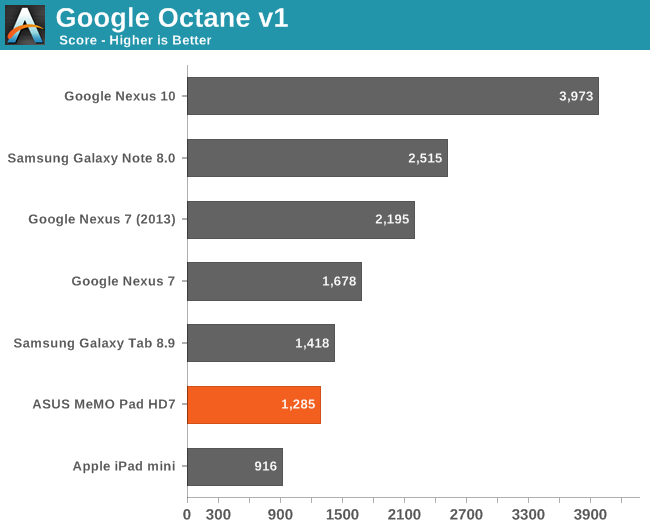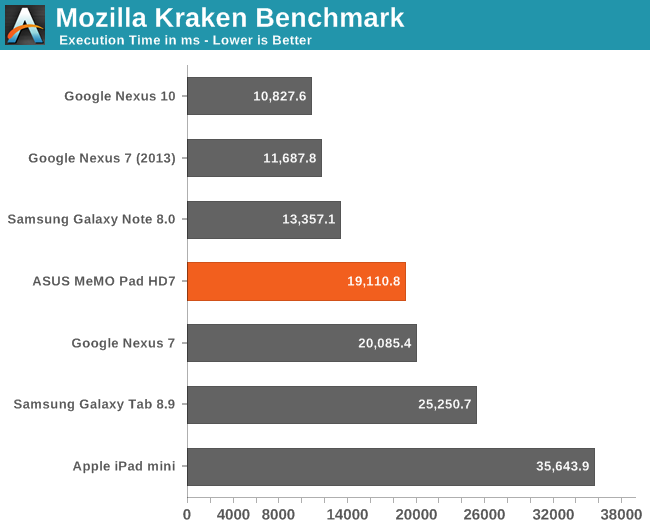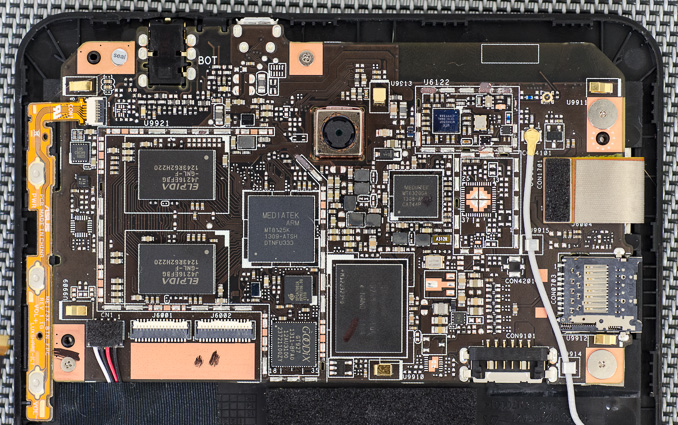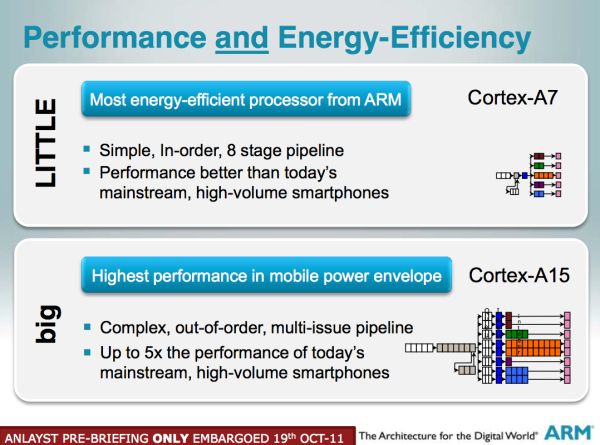ASUS MeMO Pad HD7 Review: $149 Nexus 7.1 Successor & Our First Look at MediaTek's MT8125
by Anand Lal Shimpi on July 29, 2013 3:55 PM EST- Posted in
- Tablets
- Asus
- Mobile
- Android 4.2
- MeMO Pad
MediaTek MT8125 Inside
To hit its $129/$149 price point, ASUS outfitted the MeMO Pad HD7 with a quad-core Cortex A7 based SoC from MediaTek: the MT8125. Before we get to the specifics of this SoC, it's important to put MediaTek in perspective since this is the first time we've ever reviewed one of its SoCs.
In our SoC coverage at AnandTech we tend to focus on the big five: Apple, Intel, NVIDIA, Qualcomm and Samsung. TI dropped out of the AP (Application Processor) space, and ST-E's future as a company is a bit uncertain. The benefit of ARM's business model however is that anyone can put its cores and/or ISA to use. You just need to have enough funding to pay for an ARM license and build an implementation team to get your SoC off the ground. While we're used to low cost markets being addressed by de-featured versions of high-end chips, in the ARM ecosystem there's another solution: the rise of the high-volume, low cost SoC vendor.
MediaTek, a Taiwan based fabless semiconductor manufacturer, is one of a number of ARM licensees that are presently giving Qualcomm (and other mobile SoC vendors) a hard time. They tend to take vanilla ARM (and 3rd party) IP, integrate it, and sell it for much less than the ARM licensees we're used to covering. Just as ARM's licensees are putting incredible pressure on Intel's margins in client computing, MediaTek is doing the same to the bigger ARM licensees.
Last year MediaTek shipped just under 1.7 billion chips. Granted that's across all markets that it serves (including APs, WiFi, GPS, DVD/BD player chipsets, etc…), but it's still tremendous volume.
If you look at any of the sub-$150 Android tablets these days, they all integrate some form of ultra low cost silicon. In large, cost-sensitive markets (e.g. China), MediaTek's presence is extremely high.
The MT8125 integrates four relatively early revision ARM Cortex A7 cores (r0p2). Each core can run at between 500MHz and 1.2GHz, and each core can be hot-plugged independently. I ran a bunch of low level memory tests and it looks like MediaTek opted for a fairly sensible 32KB/32KB L1 cache configuration (I$/D$). The L2 cache appears to be 1MB in size, shared between all four cores. NEON is supported.
Of the four cores, I noticed the first two are frequently active, with clock speeds usually up at 1.2GHz whenever you're doing anything (loading apps, scrolling, etc…). The third core usually plugs in to keep responsiveness up while doing anything more CPU intensive. The fourth core seems to occasionally get plugged during normal, non-heavily threaded use, but even then for very short periods of time.
We've only briefly discussed ARM's Cortex A7 here, so I'll offer some more details on the architecture since it's relevant. The Cortex A7 is ARM's Cortex A5 successor. It's a light-weight 32-bit core that is fully ISA compatible with the Cortex A15 (which is why we see it used in big.LITTLE configurations with the A15). The A7 is a fully in-order micro-architecture, unlike the OoO Cortex A9 (at least with respect to integer instructions). The A7's integer pipe is 8 stages deep, and has limited dual-issue capabilities (e.g. FP/NEON can't be dual-issued, branches can only be issued from one port, etc…). The execution back end is quite similar to the Cortex A8.
ARM's goal with the Cortex A7 was to deliver similar performance to the Cortex A8, but in a smaller area and at lower power. ARM claims a single Cortex A7 core could be fit into a 0.5mm^2 area on a modern 28nm process. That's roughly 1/6 the area required to implement a single AMD Jaguar core.
Feeding the quad-core Cortex A7 cluster is a single-channel (32-bit wide) DDR3L memory interface. ASUS opted for two 16-bit DDR3L-1066 devices on-board. My review sample used Elpida DDR3L, the same type found in iFixit's teardown of the new Nexus 7.
Performance in our standard suite of web based tests has the quad-core Cortex A7 MT8125 trading blows with the quad-core Cortex A9 Tegra 3 in the Nexus 7. When the two are similar, they tend to be pretty close, but when there's a lopsided victory it's usually well in favor of the Tegra 3/Nexus 7. That tends to mirror my experience with the MeMO Pad HD7. In many cases it feels close to the 2012 Nexus 7's performance, but there's an element of snappiness that's just not present. Some Android animations are a little choppier (e.g. bringing up the apps grid) compared to the Nexus 7. I do wonder how good MediaTek's memory controller implementation is. Remember that ARM only has to provide the CPU IP, the rest of the SoC is up to the designer to build/source.















75 Comments
View All Comments
n0b0dykn0ws - Monday, July 29, 2013 - link
Given the MicroSD card slot I would highly consider getting one of these and using it for on the go media, especially for the kids.YaBaBom - Tuesday, July 30, 2013 - link
+1 for kids... Especially since this tablet actually outlasts the Nexus 7 in the 3D tests--i.e. gaming. Seems like a pretty well balanced tablet.synaesthetic - Wednesday, July 31, 2013 - link
Shame the 8GB model isn't available in the US. >< I would love to have the 8GB model and throw a bigass sdcard in it, then fill it full of movies.anxyandy - Thursday, August 8, 2013 - link
Hmm, I think the SD card is the only advantage over the Nexus 7! I would just pay the tiny bit extra, for what is one of the best tablets on the market!!!Have a look:
Direct updates by OS vendor Yes vs No It can be updated directly by the OS vendor, so no need to wait until the manufacturer or network provider releases an update.
Significantly higher pixel density 323 ppi vs 216 ppi 49.54% higher pixel density.
Reasonably more RAM memory 2 GB vs 1 GB 1 GB more RAM memory.
Lots narrower 114 mm vs 120.6 mm 6.60 mm narrower.
Thinner 8.65 mm vs 10.8 mm 2.15 mm thinner.
Much faster CPU clock speed 4 x 1.5 GHz vs 4 x 1.2 GHz 25% faster CPU clock speed.
Has NFC Yes vs No Near-field-communication (NFC) allows wireless transactions like payments.
Wireless charging Yes vs No It can be charged w/o any plugs and wires similar to electric shavers or toothbrushes (as extra).
Source; http://versus.com/en/asus-memo-pad-hd7-vs-google-n...
BryanDobbins - Saturday, August 17, 2013 - link
my buddy's aunt earned $14958 past week. she been working on the laptop and got a $510900 home. All she did was get blessed and put into action the information leaked on this site... http://xurl.es/qa0ukuhuznaa - Monday, July 29, 2013 - link
Does the MicroSD slot support SDHX? Or in other words: What size of potential memory expansion are we talking about here?Death666Angel - Monday, July 29, 2013 - link
Found one guy in a forum saying his 64GB SDXC doesn't work, but he didn't elaborate on the file system used or what didn't work.gorskiegangsta - Monday, July 29, 2013 - link
I believe SDXC cards use the ExFAT format.madmilk - Monday, July 29, 2013 - link
Maybe exFAT is the most common, but there's nothing stopping you from formatting an SD card as say, ext4.hrrmph - Monday, July 29, 2013 - link
64GB Micro-SDXC cards from SanDisk come pre-formatted with exFAT.I can attest that they work fine in a Samsung Note 2 and it's widely published on forums that other Samsung devices work fine with these cards.
The Blackberry Z10, and possibly other BB OS 10 devices, require the card to be reformatted to FAT32. This works fine, except that you are subjected to the 4GB file size limit of FAT32. For most uses this isn't a problem, but if part of your usage scenario is wanting to backup a few large files, in addition to all of the smaller, more typical file sizes that you would normally carry, then the Blackberry isn't the appropriate tool.
Also, you cannot then swap Micro-SDXC cards between a Blackberry device and a device that uses the more modern exFAT file system. For example, lets say you shot photos and video using a Z10 and saved it on the Micro-SDXC card in the required FAT32 format. You couldn't then put the card into a more modern tablet's Micro-SDXC exFAT enabled slot to display the photos and video to your friends.
But, if you shoot photos and video on a Samsung device (Note 2, S4, S4 Mini), you could then swap the Micro-SDXC exFAT card over to another device with a Micro-SDXC exFAT enable slot (I believe the Samsung Note 8, Tab 7, and possibly some of the other major name brand soon-to-be-released devices coming out of Asia) to easily display your photos and video to friends and family.
Many of the smaller devices are shooting 1080P video, but I'm not aware of any 7" or 8" tablet with a Micro-SDXC exFAT enabled slot that has the requisite 1080P screen to display the videos in full resolution once the Micro-SDXC card is swapped over to the larger display device.
In addition to capacity expansion, I also find it easier to get files in and out of my devices and PCs quickly with the Micro-SDXC cards.
That is why (for me) it is so frustrating to see Google Asus build such a nice Gen 2 Nexus 7, but leave off the fundamentally important Micro-SDXC slot. My main reason for wanting to replace my Gen 1 Nexus 7 is the lack of a Micro-SDXC slot. The Samsung Note 8 has the slot, but lacks the 1080P display.
Coming back to the Asus HD7, I realize that it is a budget device and makes no attempt to compete at the high end. The screen isn't 1080P for example. But, until we get devices that universally have Micro-SDXC exFAT enabled slots, we are looking at a fragmented market where devices don't inter-operate that well together.
It would be interesting to know what the retail incremental cost of a Micro-SDXC exFAT enabled slot is compared to the cost of a Micro-SDHC slot.
Maybe Asus can't hit their target price on the HD7 with a modern Micro-SDXC slot. Or maybe they are taking a page out of Samsung's book (e.g. S4 Mini) and will under-promise and over-deliver by giving us the more modern slot in the end anyway.